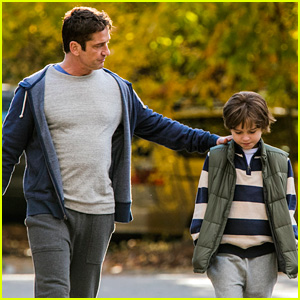Plot
Dane Jensen (Gerard Butler) is a successful Chicago-based corporate headhunter who works at the Blackridge Recruitment agency. His life revolves around closing deals in a survival-of-the-fittest boiler room. As the film opens Jensen is shown to be focused on his job, but he also tries to be a family man. His boss Ed Blackridge (Willem Defoe) is offering Jensen a promotion that will lead to Jensen controlling the company. But in order to secure the promotion, he must beat his ambitious rival Lynn Wilson's (Alison Brie) numbers. Jensen's focus on the job becomes a detriment to his family. His wife Elise (Gretchen Mol) asks for more of his time with the family.
Jensen tries to spend some quality time with his oldest child Ryan (Maxwell Jenkins), to prepare Ryan for the adult world. Jensen finds Ryan on the verge of childhood obesity and takes him jogging in the morning. Jensen notices that his son is constantly complaining of tiredness and has bruises. Jensen works harder and spends more time at the office to try to get the promotion, but it does not sit right with Elise. She asks him to prioritize. Ryan is later diagnosed with cancer, which shocks Jensen. He spends more time with his son, which causes his numbers — a prerequisite of the promotion — to drop. Meanwhile, Lynn takes the opportunity to tap into his clients and scores. The film culminates with Ryan falling into a coma before getting better, and Jensen losing his job at Ed's firm, due to not making profit. But the strict Ed releases Jensen from his non-compete agreement. Jensen starts his own company, but is also invested with his family.
A Family Man 2016 Trailer
Character – Establishment, Development, Motivation & Relationship
Character motivation is a good indicator of ideology. In mainstream texts, the protagonist is often motivated by the need to restore order and set the social values right, according to the society and its beliefs at the time the text was produced and distributed. Their motivation will often reflect the dominant ideology of the time and society.
Antagonist will often reflect the opposite belief and as a result the audience will seek revenge against the character and want them to be punished for their actions or have the character feel a sense of reflection for their attitudes and behaviors. Unless in the resolution the character has a change of heart and their evil turns to good.
Audiences can often predict character motivation, development and resolution. Creators will do this in family orientated texts. Audiences of this genre want happy endings and feel at peace with the conclusion of the narrative.
Relationships between characters are constructed to develop the narrative, building its sense of realism through dialogue and actions that represent how audiences expect characters to react to the narrative triggers introduced into the text.
Nelson Media, Flack 2018
Dane: The Business Man



Dane: The Family Man



Well written response: By Student
Explain why audiences form different time periods engage with, consume and read media narratives differently. In your response, refer to one of the narrative texts that you studied.
- 6 marks -
Society is constantly changing, therefore, creators of media texts must consider the time period and the ideologies of that time period in each phase of production. New and emerging technologies can influence the way the producer constructs the narrative and the way they engage audience because new opportunities are provided with new tools.
In the film text 'The family man' released in 2016, the role of a man and a woman are explored. This film was produced in a time where women were standing up more for what they believe in and women were becoming more and more empowered. They become less reliant on the man which caused the ideology of masculinity and femininity to evolve. The narrative of this text was centred around these new ideologies and presented to the audience.
The protagonist, Gerard Butler's character demonstrated how masculinity is becoming a man that is sensitive and emotional. He is presented as a strong, successful working man. His life revolved around his work and making the best deal in the office. This made the audience see an old-fashioned representation of masculinity and engage with Butler's character differently to someone in a different time period.
During the development of the narrative, Gerard Butler's character changes. His son develops cancer. The text creators aim for the audience to engage with the emotional rollercoaster of Gerard's character. We see a huge shift through character development when his emotions take over during the tough period and his character becomes appreciative of the time he spends with his family.
Well written response: By Student
Explain why audiences from different time periods engage with, consume and read media narratives differently. In your response, refer to one of the narrative texts that you have studied.
- 8 marks -
Audiences are influenced through many means including, reception at the time of the text release or later but also through their own emotional engagement. The narrative 'A Family Man' was released in 2016, a time where equality was becoming increasingly seen, as women were stirred to stand up to men and not appear so heavily in the background. This view changed individuals perception on the ideology of masculinity and femininity, in which this narrative is heavily based upon.
Concepts and ideas formed by media texts such as 'A Family Man' has caused audience's to engage, consume and read media texts differently. Masculinity is opening up to the idea of men being seen as sensitive and emotional, rather than strong, dominant and aggressive. Due to this shift, in 2016 when this text was released, audience's saw the protagonist of Dane Jensen as a traditional reflection of masculinity and were not as open or forgiving to his actions as a result. His life in the narrative was formed around closing deals and promotions, rather than at the beginning of the film being a good father. Due to audiences reception at the time of the text release, they adapt these feelings of the character. If the text was released in a different time period, reactions could vary significantly, with the protagonists actions being more acceptable.
Emotional engagement is reflected in the scenes of heartache, where the audience engages with the sadden facial expressions and music in the life event of Dane Jensen's child Ryan having cancer. Audience's follow an emotional journey with the narrative as the media creator intends. The mother thoroughly supporting the child in all aspects of the journey connects with readers, as they base their perspective of sadness and fear from her point of view. The father not coping well with the situation, learns to appreciate family time through character development. Character development is most significantly seen between the development and closure of the text. As a result of the character development the audiences emotional engagement also changes, as they see a situation like the one before them can break any character no matter how stern they appear externally.
Well written response: By Student
Outline an example of how a media code or convention has been used to convey meaning in one media narrative that you studied this year.
- 3 marks -
Director Mark Williams makes use of the structuring of time to convey the ideology of gender and masculinity in his 2016 film text, A Family Man. Mark uses repeats in the film to depict the theme and idea of masculinity. Directors of the film use repetition of shots and events in the film to really highlight the idea of Dane being a hardworking man, who spends most of his time in the office and away from his family. Mark also makes use of slow motion in certain events in the film to create tension for the audience. Mark was able to show the shifts in Dane’s character, from being a serious business man who doesn’t really show emotions, to being a really soft person on the inside, this was shown greatly through the structuring of time in the film.
Well written response: By Student
How was Structuring of time employed by the director to convey the ideology of Gender in one of the texts you studied?
- 4 marks –
The order, duration and frequency of events in media narratives can be stretched, quickened and repeated to control the audience’s consumption of the narrative’s ideology. Directors can structure their narratives in linear (chronological) order or nonlinear (non-chronological) order, depending on the intended reception. Director, Mark Williams uses the technique of repeats in his 2016 film, “A Family Man’ as an effective tool in which to display to the audience his intended depiction of masculinity. Williams highlights his perception of the protagonists, Dane’s (Gerald Butler) role as a working father in a 2016 setting. He makes effective use of the repetition of shots and events, in particular continuous scenes of Dane working late at the office, in order to provide for his family, whilst losing crucial time getting to know his family. By repeating specific scenes and highlighting to the audience the importance of these William’s persuasively shows the audience how the ideology of Gender can be represented through a working males role in 2016.
Question by student on Mise-En-Scene – Setting – Costume
Use a code or convention and discuss how it impacted the ideology in one of the media texts you studied this year. In your response, include a discussion on the society and time period the text was produced and distributed.
-7 marks -
Society is constantly evolving, and so as a result, creators of media must meet the expectations of contemporary audiences. The ways that men and women are represented in the media is concurrent with what is expected of them in today’s society. In the film text, ‘A Family Man’, mise-en-scene discloses the ideology of gender and the way that males and females are represented in this current society.
Costume and set design, as part of mise-en-scene are employed in this text to strategically convey stereotypical roles of men and women in society at the time of the film’s release, in 2016. Gerald Butler, who plays the ‘successful’ protagonist (Dane Jenson) in ‘A Family Man’ is commonly seen wearing a very neutral suit and tie – usually grey or black. Butler is cast frequently set in his, “survival-of-the-fittest”, intensely lighted boiler room at ‘Blackridge Recruitment Agency’, with a phone in hand most of the time. The costumes and sets that Gerald’s character is commonly shot in convey to the audience that he is a very career-driven and serious man – a classic stereotype of American men in the year 2016.
Moreover, Gretchen Mol who plays Danes wife, Elise, is presented as a very involved, emotional, stay at home mum. This explicit female ideology is displayed through mise-en-scene. Elise is generally in scenes with her children, at home and in relaxed clothing such as tracksuits, eluding to the idea that women are to run the household whilst men earn the income. Director Mark Williams has employed a series of techniques such as costume and set designs to show the audience how the ideology of gender can be represented through the roles of men and women.
Well written response: By Student
Explain why audiences from different time periods engage with, consume and read media narratives differently. In your response, refer to one of the narrative texts that you have studied.
- 8 Marks -
Society and its views on many different ideologies is constantly adapting and developing over time. With this shift, we see the media chasing it, trying to keep up with what their audience expects and wants. A film perfectly acceptable 20 years ago if released today, could cause an outcry of anger regarding a range of topics spanning from race to gender and anywhere in between.
The Film text “A Family Man” released in 2016 begins to more carefully consider masculinity and what it means to ‘be a man’, something the modern American audience is intrigued by and trying to develop into a social norm. The text follows Dane Jensen, his personal story arc showing his struggle of attempting to balance his family and work life as the provider.
He begins as a character easy for the audience to dislike, being rude, arrogant and putting his job before his family who he treats in a verbally harsh way. However, when the narrative progresses and his son Ryan is diagnosed with cancer, the struggle Dane experiences becomes more intense, having to expose his vulnerability and emotions. While for a past audience this would have been frowned upon, the modern society is accepting of this, and they begin to grow fond of his character after he reaches the highest point of his story arc where he accepts his emotional side and his love for his family.
Well written response: By Student
Explain how Cause and Effect propels a narrative. Using Cause and Effect provide an example of a situation that underpins the ideology of gender in one of the texts you studied.
- 6 marks –
In order for a narrative to progress, multiple cause and effect situations are required to form a change or reaction in the plot. The relationship between cause and effect is crucial in a narratives engagement with the audience. A director will implement these events and situations in their film to effectively get the audience to consider what happened previously and begin to anticipate how the plot will progress as a result.
In the 2016 text, A family man’, Director Mark Williams uses cause and effect as an effective tool in order to present a depiction of the ideology of gender. Through the event of the protagonists (Gerald Butler) sons battle with Leukaemia, Williams provides the audience with an event in which they can consume to gain a better understanding of the protagonists strength and masculinity. This cause and effect situation specifically, allows the audience to witness a softer more feminine side of Gerald Butler’s character. By implementing a strong cause and effect situation, Williams is able to effectively engage with the audience by underpinning the ideology of Gender.
Audiences in 2016 want more from the ‘father figure’ role. They want to see compassion and understanding. In 2016 the ideology of masculinity is represented and constructed with this in mind.
Well written response: By Student
Question: Analyse how media codes and conventions have combined to create an effect on or to engage an audience in one or more of the media narratives you have studied this year. Your answer should include at least two codes and two conventions.
-8 marks-
Media creators and producers through the use of codes and conventions, attempt to encourage a target audience to engage with a consume a media product with a given ideology which reinforces such ideals, to create a casting effect on its audience.
Through the use of mise-en-scene and narrative possibilities, the 2000 text, Erin Brockovich highlights the explicit ideology of gender to its audience. Costume and Setting as a result of mise-en-scene in the opening of the narrative, represents the protagonist Julia Robert’s character Erin Brockovich. The audience identify her as an unorthodox, struggling, single mother who is searching for employment. Audiences are able to form an expectation of the development of the narrative from the opening, where the use of make-up highlight the character of Erin. The choice of costume that audiences would consider sexual and tacky to a formal job interview, provides insight into her personal background as a poor single mother, as well as her individuality to allow audiences to form narrative possibilities and expectations of her.
Structuring of time has also been employed in alternative texts such as, ‘The Family Man’, to convey the ideology of gender to an audience. The 2016 text, directed by Mark Williams uses the technique of temporal frequency to emphasise the ideology within his narrative. Protagonist Dane Jenson is represented as a working-class man during the 2016 time period. Williams attempts to convey an explicit ideology of masculinity by referring back to the setting of Jenson’s work office. Revealing this setting on numerous occasions to the audience, provokes them to identify his character as a hardworking, driven income provider for his family. These series of flashbacks also indicate to the audience that his work ethic in a 2016 American society, is required for a male to feel a sense of self-worth.
Practice Questions – SAC & EXAM
Outline an example of how a media code or convention has been used to convey meaning in one media narrative that you studied this year.
3 marks
Discuss how media code or conventions worked together to convey meaning in one part of the media narrative that you have studied tis year.
7 marks
Use a code or convention and discuss how it impacted the ideology in one of the media texts you studied this year. In your response include a discussion on the society and time period the text was produced and distributed.
5 marks
Analyse how media narratives are shaped by the ideological context in which they were produced, distributed, consumed and read. In your response refer to media narratives that you studied this year.
10 marks